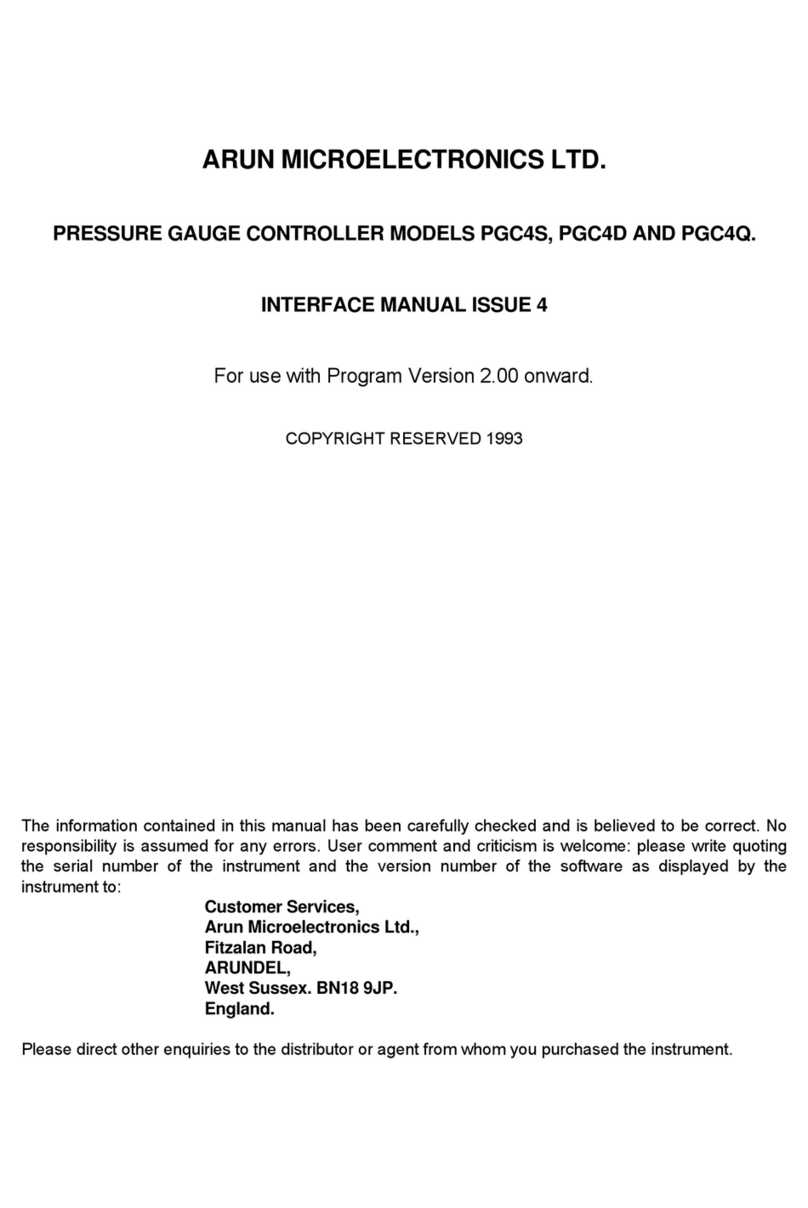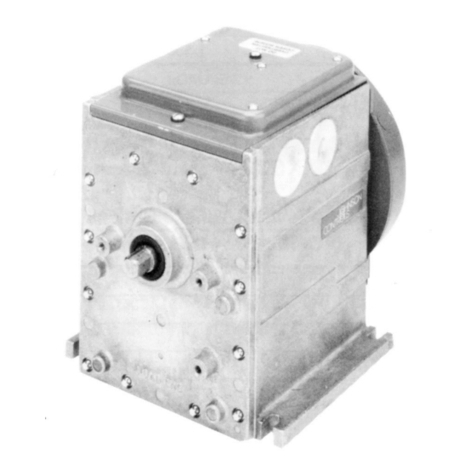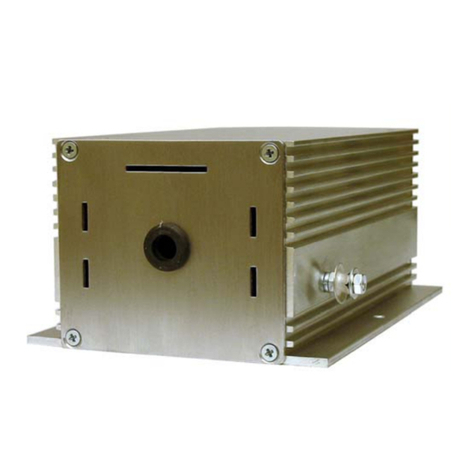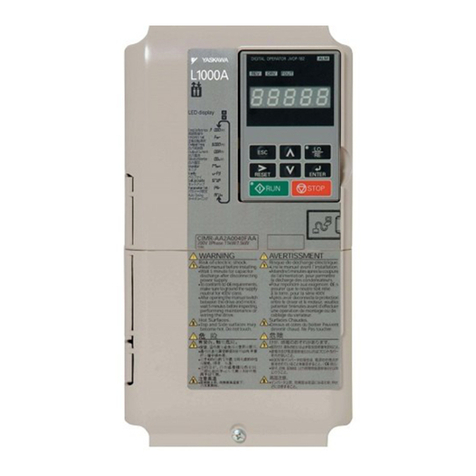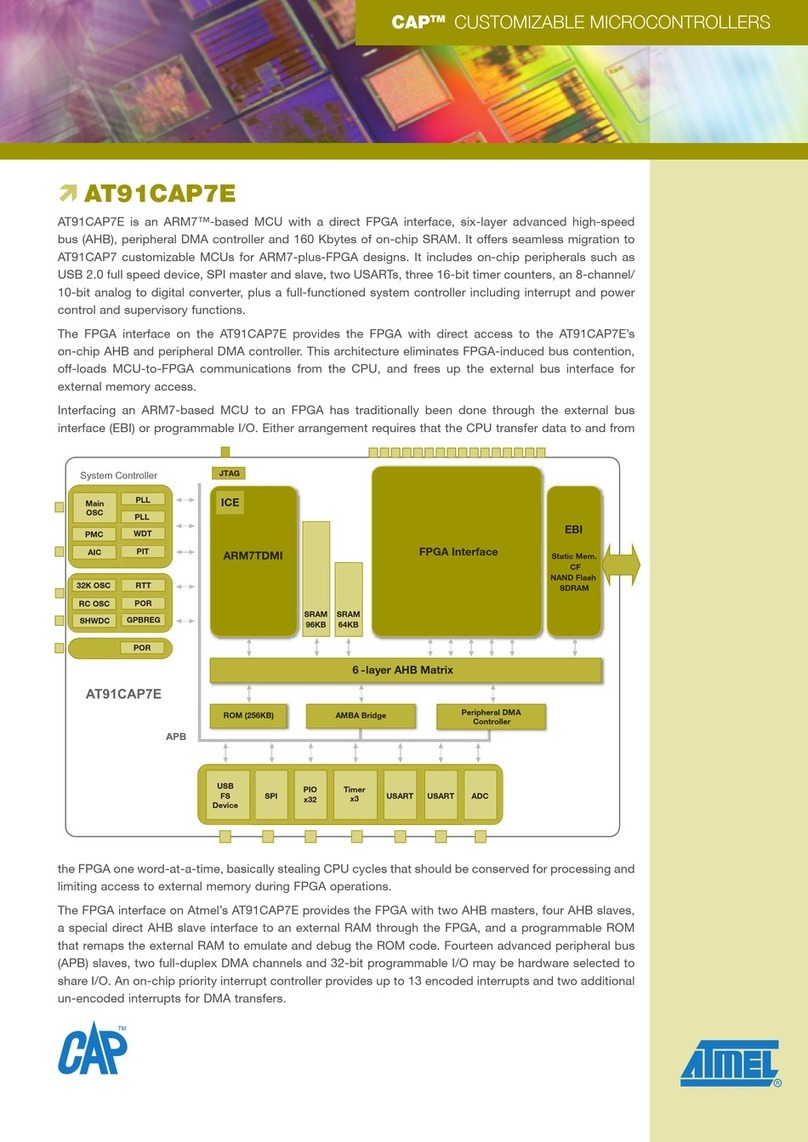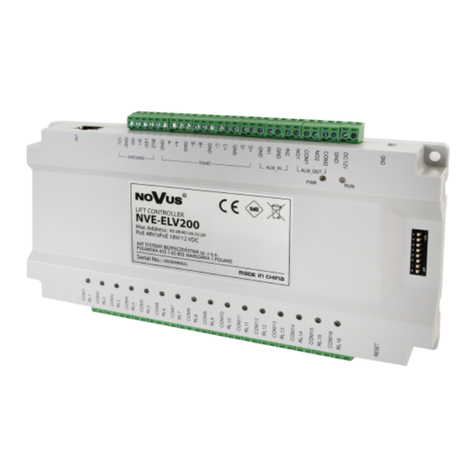Arun Microelectronics LTD NGC2D User manual

Pressure Gauge Controller - Model NGC2D
USER MANUAL
ISSUE 2.5
For use with program version 6.1.x


Section Page
1 Introduction ……………….……………………………………………………………………………….............. 2
1.1 Scope of this manual ……………………………….…………………………………………….………………………………………………………. 2
2 Technical Data ………………………………………………………………………………………………………………. 2
3 Warnings & Safety ………………………………………………………………………………………………………. 4
4 Installation …………………………………………………………………………………….……………………………. 4
4.1 Instrument …………………………………………………………………………………………….………………………………………………………. 4
4.2 Ion Gauge ……………………………………………………………………………………………..……………….............................. 6
5 Front Panel …………………………………………………………………………………………………………………. 7
6 Setup ………………………………………….………………………………………………………………………………. 8
6.1 Switching On …………………………………………………………………………………………………………………………………………………. 8
6.2 Setup …………………………………………………………………………………………………………………….………………………………………. 8
Passwords / Units ………………………………………………………………………………………………………………………………………. 8
Interlock / Autostart …………………………………………………………………………………………………………………………………. 9
Gauges ……………………………………………………………………………………………………………………………………………………….. 9
Relays …………………………………………………………………………………………………………………………………………………………. 10
Bake ………………………………………………………………………………………………………………...……………………………………….. 10
TSP …………………………………………………………………………………………………………...………………………………………………… 11
Degas ………………………………………………………………………………………………………………………………………………………….. 11
7 Operation ……………………………………………………..………………………………….……………………….. 12
7.1 Function switch in Operation ………………………………………………………………………………………………………………………. 12
7.2 Relay Trip Levels ………………………………………………………………………………………………………………………………………….. 12
7.3 Display Sequence ………………………………………………………………………………………………………………………………………….. 13
Pirani …………………………………………………………………………………………………………………………………………………………. 13
Leak Detector ……………………………………………………………………………………………………………………………………………. 13
Ion Gauge Sensitivity …………………………………………………………………………………………………………………………………. 13
Temperature ………………………………………………………………………………………….…………………………………………………. 13
Capacitance Manometer ……………………………………………………………………...………………………………………………….. 13
8 Ion Gauge Operation ………………………………………………………………………………………………….. 14
8.1 Display Sequence in Emission …….…………………………………………………………………………………………………………………. 14
Starting the Ion Gauges ………………………………………………………………………………………………………………………………. 14
Emission Change …………………………………………………………………………………………………………………………………………. 14
8.2 Changing Emission Current ……………………………………………………………………………………………………………………………. 15
8.3 Prompted Emission Change …………………………………………………………………………………………………………………………… 15
9 Degas ……………………………………………..………………………………………………………………………….. 15
Manual ……………………………………………………………………………………………………………………………………………………….…. 16
Programmed …………………………………………………………………………………………………………………………………………………. 16
Quick …………………………………………………………………………………………………………………………………………………………….. 16
10 Bake ……………………..…………………………………………………………………………………………………….. 17
11 Capacitance Manometer ……………………………………………………………………………………………. 18
12 Recorder Output ……………………………………………………………………………………………………….. 18
13 External Inhibit ………………………………………………………………………………………………………….. 18
14 Windows Software ……………………………………………………………………………………………………….. 18
15 Remote Operation ……………………………………………………………………………………………………… 19
16 Troubleshooting ………………………………………………………………………………………………………… 22
15.1 Fan slow / failed …………………….……………………………………….……………………………………………………………………………. 22
15.2 Temperature ……………………………………………..…………………….……………………………………………………………………………. 22
15.3 Emission Fault ………………………………………..……………………….……………………………………………………………………………. 22
15.4 IG Fil O/C ………………………….…………………………………………….……………………………………………………………………………. 22
15.5 Password Forgotten? ………………………….…………………………….……………………………………………………………………………. 22
15.6 Ion Gauge Connections …………………………………………………….……………………………………………………………………………. 23
17 Assistance …………………………………………………………………………………………………………………… 23
Appendix A
Gauge Principals …………………………………………………………………………………………………………………………………………… 24

© Arun Microelectronics Ltd 2015. All rights reserved Page 2
1 Introduction
The NGC2D process controller is a high-accuracy Bayard-Alpert (BA) ion gauge controller that offers integrated
pressure measurement and process control. The controller operates from electrical supply voltages in the
range 100 to 240 volts and frequencies of 48 or 65 Hertz.
The controller may be used with UHV ion gauges incorporating tungsten or coated iridium filaments. The
controller can operate two ion gauges sequentially, two AML Pirani gauges and one capacitance manometer.
Four power relays for process control are provided as is an internal thermocouple amplifier for bakeout
control. Automatic control of a titanium sublimation pump controller is also featured.
1.1 Scope of this manual
This manual provides installation, operation and maintenance instructions for the Arun Microelectronics Ltd
Ion Gauge Controller model NGC2D. Please read this manual before attempting to install and operate the
controller.
This manual contains essential safety information which supplements the safety features of the controller.
Safety procedures are highlighted as WARNING instructions by the symbol below. Failure to observe the
instructions could result in injury or death to persons.
2 Technical data
2.1 Mechanical Data
Dimensions 19” full-width rack
Height: 1U.
Depth: 270mm, excluding connectors
Weight 2.7kg
2.2 Electrical Supply
Supply Voltage 100 to 240 Volts nominal at 48 to 65 Hertz, auto adjusting
Power Consumption Less than 20 Watts idling
Less than 75 Watts in emission
Fuse 2.0 A (T), 5x20mm
Supply socket IEC 320-C14
2.3 Environment
Operating temperature 5°to 35°C for specified performance
Operation is inhibited at greater than 40°C
Storage temperature -10°C to 70°C
Relative Humidity (non condensing) 10% to 90%
Maximum operating altitude 2000 m
Pollution category – EN61010 1

© Arun Microelectronics Ltd 2015. All rights reserved Page 3
2.4 Electrometer
Logarithmic conformance
2.5 Ion Gauge
Suitable type UHV Bayard-Alpert gauges
Range 1x10
-3 to below 3 x 10 -11 mbar. Dependant on gauge-head
Grid +200 V d.c. (+500 V at 60mA in Degas)
Filament Tungsten: ≤12 V at ≤4.2 A
Coated iridium: ≤12 V at ≤2.6 A
Filament power limited to > 30 Watts
Filament bias: +50 V
Collector 0 V (virtual earth)
Emission current Soft-start emission control at 0.5mA or 5mA
Sensitivity adjustment 1 mbar
-1 to 140 mbar -1
2.6 Pirani Gauge
Suitable type Constant-voltage, half bridge. Calibration at connector
Range 1x10-3 mbar to 200mbar
2.7 Capacitance manometer
Suitable type Self-powered with +10 V full-scale output.
1, 10, 100 or 1000 mbar or Torr
2.8 Process trips
Relays Four x single pole, change-over. 5 A at 240 V maximum
Assignment Independently assignable to any gauge
2.9 Bake-out
Thermocouple type Mineral-insulated K-type with miniature flat-pin connector
Programme Settable bake temperature (50-250°C), bake time (1Hr to
90Hrs) and overpressure limit
2.10 Communications
Interface RS232C
Settings 1200, 2400, 4800 or 9600 (Default) baud,
8 data bits, 1 stop bit, no parity, no handshaking
Range 21°C +5°C to +35°C
1mA to 350pA <1% <1%
<350pA to 10pA <1% <4%
<10pA to 2pA <10% <20%

© Arun Microelectronics Ltd 2015. All rights reserved Page 4
3 Warnings and safety
WARNING – Safe operation of ion gauges requires grounding of all exposed
conductors of the vacuum system, gauges and controller. LETHAL VOLTAGES
may be established under some operating conditions unless correct grounding
is provided. All exposed and isolated metal parts should therefore be reliably
grounded to a common system earth point via 4mm2or thicker copper
wire/braid, the integrity of which should be checked regularly. No ferrite
components should be installed.
High voltages are present within the instrument when operating and for some seconds after
switching off. Remove the mains lead before removing the cover for any reason.
Ensure that maintenance is carried out only by suitably trained personnel.
Instruments are shipped with password protection disabled. If you set a password you must record what it is.
Password usage restricts access to most functions of the instrument, other than pressure measurement.
The conditions set at manufacture assume that you do not require any interlocks and that the ion gauge has
a Tungsten filament. You may fuse coated Ion Gauge filaments if you do not set up the instrument
appropriately.
Allow several minutes for Pirani gauges to reach operating temperature after switching on before using them
for interlock, autostart or process control.
Two fans are used sequentially for cooling. Orange Status LEDs on the front panel indicate which fan is being
used. If a fan fails a message is displayed at the time of failure and the LED for that fan flashes thereafter.
Operation with only one fan is permissible but replace a failed fan as soon as possible. If the remaining fan
fails, operation of the ion gauge will be disabled. Replacement fans must conform to the specification printed
on the rear panel and are available from AML.
Discharges from X-ray power supplies and other high-voltage and high-energy sources (which are commonly
used in vacuum systems) into the Ion Gauge may damage the instrument. Such damage is not covered by the
warranty. Discharge damage will be minimised by decreasing the impedance of the strap/cable from the
earth stud on the instrument to the vacuum system earth distribution point. This connection may also be
essential for operator safety: follow the safety instructions and recommendations of the supplier of any high-
voltage equipment used in the vacuum system.
4 Installation
Checks on receipt of the instrument
On receipt of the instrument remove all packing material and check that all items on the shipping list have
been received. Report any damage or shortages to the Company or the Distributor who supplied the
instrument. The packing material has been specially designed to protect the instrument and should be
retained for possible future use.
4.1 Instrument installation
Mounting
The instrument is suitable for mounting in a standard 19" rack and occupies 1U (1.75”, 44.5mm) of the rack.
The mounting holes in the front panel are intended for retaining the instrument in the rack and will not
support its weight. Additional support is required toward the rear and various arrangements are provided by
rack manufacturers for this purpose.

© Arun Microelectronics Ltd 2015. All rights reserved
Page 5
Ventilation
The instrument is forced-air ventilated through grilles on the sides and a vent in the rear panel. Mount it in a
location where there is an adequate supply of air as close as possible to cool room-ambient temperature.
The instrument is tolerant of, and is compensated for, operation at elevated ambient temperatures up to 40°
Celsius. Long-term accuracy and reliability will be enhanced by operation at the lowest possible temperature.
If there are other instruments in the rack which generate significant amounts of waste heat, try to ensure
that this is deflected away from this instrument.
Line Power Connection
The NGC2D operates from a 100V to 240V nominal AC power source having a line frequency of 48 to 65 Hz.
Use a three-wire power cord to connect to a properly grounded wall outlet.
Line Fuse
There is a line fuse located on the inside of the instrument on the rear of the power inlet connector. A spare
fuse is located in a replacement fuse holder on the circuit board. Replacement fuses must be T2.0A. High
voltages are present within the instrument when operating and for some seconds after switching off. Remove
the mains lead before removing the cover for any reason.
Grounding
The instrument earth stud must be connected directly to the vacuum system
earth distribution point with a low-impedance strap/cable (>=4mm2or 12awg):
there must be no ferrite components installed on it.
Ion Gauge 1 & 2
Use AML-approved gauges with properly-screened leads. The ground braid of the ion gauge cable must be
connected to the instrument ground stud.
Ion gauge leads should not be installed close to cables carrying high
alternating currents or through areas where there are significant
alternating magnetic fields. They should be constrained, since
movement or vibration will generate charges or currents and these may
disturb UHV pressure readings.
Third-party ion gauge cables may not allow compliance with EU EMC
Directives and may lead to unstable emission. As a minimum there must
be an overall screen on the lead and an inner screen on the collector
connected to the BNC shell. These screens must not connect either to
the vacuum chamber or to each other. Interlock pins 1 & 3 must be
connected together.
Pirani 1 & 2
AML Pirani gauges PVU or PVB are suitable for use with this instrument. Pirani 1 pressure is used for Ion Gauge
1 Interlock and Autostart functions and should be installed in the same chamber as the Ion Gauge. Pirani 2
is normally used for backing-line pressure measurement.
Ion Gauge Connector Pin Allocations
Pin Function
1 Interlock
2 Grid
3 Interlock
4 Filament Common
5 Filament 1
6 Filament 2

© Arun Microelectronics Ltd 2015. All rights reserved Page 6
Relays
Four single pole, change-over relays are provided for process control and can be independently assigned to
any gauge. Contacts are rated at 5A, 240V maximum. The contacts of the relays are shown diagrammatically
on the rear panel legend, in the de-energised condition, adjacent to the terminal blocks to which they are
connected.
Inductive loads, including contactor coils, should have "snubber" networks connected in parallel to avoid arc
generation which could interfere with the operation of this and other equipment. The external wiring is
connected to the instrument through a two-part pluggable terminal block. This can be removed and wired
independently of the instrument. Ensure that external wiring is of adequate cross section for the load current.
Strip and twist the wires (do not tin them) and poke into the receptacle in the terminal block. Close the leaf
on the wire by tightening the screw immediately above. Take appropriate action to strain-relieve the wiring
nearby and to restrict access to the terminals if harmful voltages are to be present. Fit the terminal block
cover supplied.
If the Bake function is to be used then relay D must be assigned to Bake. It is used to switch on the Bake
heaters when energised. Do not connect heaters directly to relay D: use a contactor and fit a snubber directly
across its coil. The pressure measurement during the bake cycle is read from Ion Gauge 1 only.
If the TSP function is to be used then relay C must be assigned to TSP. Relay C is energised for 0.5 seconds
to fire the TSP. Consult the TSP manual for further information. The pressure measurement for TSP control
is read from Ion Gauge 1 only.
Bake Thermocouple
The K thermocouple tip must be isolated from the vacuum chamber and situated where it accurately
represents the bake temperature. Mineral-insulated thermocouples with a miniature flat-pin thermocouple
connector should be used.
Auxiliary Connector
The Auxiliary (AUX) connector terminal block is plug-in with pin assignments indicated on the rear panel
legend. The Capacitance Manometer output is connected to CM and 0V (Refer to section 12). The recorder is
connected between REC and 0V (Refer to section 13). Connecting ILOCK to 0V will prevent ion gauge emission
(Refer to section 14).
Serial Connector
The serial interface is RS232-compatible and only one instrument may
be connected to each computer serial port. (A USB to RS232 serial
adaptor may be required)
The connector is a 9 way “D” type female connector. The pin numbering
has been chosen so that a 9-way ‘straight-through’ male-to-female
cable will be satisfactory for use with a PC serial port.
4.2 Ion gaugehead installation
Consult the information supplied with the gauge-head for advice on flanges, gaskets and adaptors for
mechanical fixing.
Mount the gauge-head in a position where the free electrons generated in its vicinity will not affect other
equipment. The performance of the ion gauge may be affected by other electron or ion generating processes
within the vacuum chamber: should shielding of the gauge-head be necessary, ensure that the conductance
between the gauge-head and volume of interest is not significantly decreased by its presence. The orientation
of the gauge-head should be such that the filament is to the side of, or below, the grid structure. This will
ensure that if the filament should sag or break it will not short-circuit to the grid.
The gauge and controller are protected from all normal failure modes of either. Users should be aware of
potential hazards from other equipment, particularly those introducing high voltages into the vacuum
chamber.
Serial Connector Pin Allocations
Pin Function
2 Tx
3 Rx
5 GND

© Arun Microelectronics Ltd 2015. All rights reserved Page 7
5 Front panel
The rotary Function Switch has two sets of positions: for setup
and operating. The SETUP locations are labelled in orange
print. The switch must be stationary for a brief time before any
action results.
INC, DEC and ENT are pushbutton switches
with tactile feedback. They select the
format of pressure display, modify setups and
change parameters before and during Ion
Gauge operation. Only press one switch at a
time.
A set of status LEDs are situated in the Status Window. The LEDs on the
right side of the window show further information about operations
involving the Ion Gauges, such as the Degas program in use. The LEDs on
the left side indicate the status of the instrument, the fans and the
number of the filament and gauge in use.
Flashing of the display or of individual LEDs either require a response by
the user or indicate an error/fault condition.
The messages and displays shown in the large display window are largely
self-explanatory and may be accompanied by sounds. The legends above
and below the display window indicate the units and the exponent scale
for interpreting the bargraph displays of Ion Gauge pressure.
LEDs indicate the status of
the four relays available for
pressure-related control,
Bake and TSP control. Each
LED illuminates when the
associated relay is
energised.
The units of the pressure display are indicated by one of three
LEDs in the display area. The centre orange LED indicates that
mBar has been selected, the green LED above it indicates Pascal
and the green LED below indicates Torr.

© Arun Microelectronics Ltd 2015. All rights reserved
Page 8
6 Setup
New users should explore and familiarise themselves with the use of the controls and displays before
connecting any gauges or wiring to the rear panel.
6.1 Switching on
Turn the Function Switch to the OFF position. Connect and switch on the mains supply and wait for the start-
up messages to run (approx. 5 seconds). During this time, both fans are checked for correct operation. The
last display in the sequence will show Pirani 1 pressure or capacitance manometer pressure (if enabled).
Pirani gauges take some time to stabilise before they indicate correct pressure. If Pirani 1 is not connected
the display will show ‘PG1 >200mB’. If the Function Switch is at a position calling for emission at switch-on,
emission is inhibited and 'Switch Em Off' is displayed.
6.2 Setup, General description
Setups are distributed among six switch locations in order to reduce the time taken to modify parameters.
There is no restriction on when, how many times, or in what order you can enter a particular setup.
You may move the Function Switch part-way through a sequence if you do not wish to modify subsequent
settings within a setup. E.g. in SETUP GAUGES you may change the filament in use without progressing through
filament material, overpressure, etc..
If the instrument is waiting for a response from you then part of the display will flash, indicating that a choice
can be made, or a setting edited. ▲and ▼
modify the choice or setting and ENT confirms it. If you do not
modify the displayed setting for a few minutes the instrument will beep periodically. If you do not respond
for a further few seconds then the current display will be replaced by ‘Setup Aborted’ and the setting or
choice at the aborted stage will revert to its former setting.
If you move the Function Switch after modifying a choice or value but have not confirmed it with ENT then
the existing choice or value is unchanged.
If you do not require the Bake or TSP functions they can be disabled by not assigning relays to them.
Setups and access to operating parameters and functions can be password-protected to prevent unauthorised
use.
Password / Units
Set Password?
Press ▲or ▼to select if a password is to be used. Press
ENT to confirm.
If a password is to be used.
Change each character with ▲or ▼and confirm with ENT.
Select the units of pressure display. (mBar, Pa or Torr)
The current selection will flash in the main display.
Press ▲or ▼to select 1 or 2 decimal place ion gauge
pressure display.
Select if gauge pressures greater than 1mB should be
displayed in scientific notation or decimal notation.
Select Yes to assign a 3-7 character instrument ID.
Change each character with ▲or ▼and confirm with ENT.
If enabled this ID will be shown during start-up and is
available as an item in the main display sequence.

© Arun Microelectronics Ltd 2015. All rights reserved
Page 9
Select your preferred baud rate. 9600 is the default for
all AML software.
Select Yes and confirm to return the instrument to its
factory default settings. All user settings will be lost.
Interlock / Autostart
Define Interlock, Yes or No.
Interlock prevents the ion gauge operating when Pirani 1
pressure is above a set pressure.
Change the set pressure with ▲or ▼and confirm with ENT.
Define Autostart, Yes or No.
Autostart starts the ion gauge the first time Pirani 1
pressure falls below the set pressure.
The set pressure is the same for both functions. If they
are used together Interlock is suspended until the Ion
Gauge has started.
Gauges
Select the filament in use for each Ion Gauge.
Change of the filament in use is allowed without entering
the password if set.
Define the filament material type for each gauge. This
automatically sets the current limits for the filaments.
Use the Iridium setting for thoria or Yttria-coated Iridium
filaments.
Set the ion gauge overpressure trips (OVP) to suit the
filament material and your customary practice. The OVP
will automatically restrict the maximum trip pressure of
any relay assigned to that gauge to half the OVP.
A maximum OVP of 1e-3 mB/Torr is recommended for an
AIG17G with Tungsten filaments or 1e-2 mB/Torr with
coated filaments.
Define whether you require the instrument to change
emission current automatically. If set to ‘No’ the
instrument will suggest when a manual change in emission
current is appropriate. Refer to section 8.2 for Ion Gauge
emission details.
Define whether you wish to add ion current to the Gauges
Display Sequence. Ion current in Amps will be displayed
following numeric ion gauge pressure.
Pirani Gauges can be switched on or off. Switching off
suspends the operation of the Pirani Autostart and
Interlock functions.

© Arun Microelectronics Ltd 2015. All rights reserved
Page 10
____________________________________
Relay C additional assignment
Relay D additional assignment
Gauges (Cont.)
Define whether you have a Capacitance Manometer (CM)
connected.
Change the full-scale pressure with ▲or ▼and confirm
with ENT.
The full-scale pressure and units of the CM are as defined
by the manufacturer for +10v output.
The units of display are chosen independently under
PASSWORD/UNITS.
Select Yes to change the default gauge labels.
Each gauge can have a user defined, three character
gauge label. Select each gauge in turn and change each
character with ▲or ▼and confirm with ENT.
Relay Assignment
You can assign any relay to any gauge or to ‘None’.
Relays assigned to ‘None’ are permanently de-
energised.
Trip levels are set to maximum on assignment.
Trip levels for relays are set using the TRIPS push-button
and can be modified when the Function Switch is at
position IG1, OFF or IG2. Refer to section 7.2 for
instructions on trip settings.
Relay ‘C’ can also be assigned to trigger the TSP and
Relay ‘D’ to Bake.
Bake
Set the bake temperature setpoint (50-250°C), total
bake time (1Hr to 90Hrs) and overpressure setpoint as
required.
During Bake relay D is energised when both the
temperature and pressure are below their setpoints.
The hysteresis on temperature is 5C° and on pressure is
50%. Refer to section 10 for more information.

© Arun Microelectronics Ltd 2015. All rights reserved
Page 11
____________________________________
TSP (Ti. Sublimation Pump)
Define whether you require multiple display and
audible warnings of an impending TSP firing. The first
warning occurs 8 minutes before firing.
Define whether you require the opportunity to inhibit
TSP firing during the countdown.
Timing of TSP firings is according to a fixed table of
current pressure against the elapsed time since the last
firing. Relay C is energised for 0.5 seconds to fire the
TSP.
The first firing will occur 10 minutes after the pressure
indication falls below 1e-6mBar or 10 minutes after
starting emission if the pressure is already below 1e-
6mBar, and thereafter according to the table.
Pressure
mBar/Torr
1x10
-6 to -7
1x10
-7 to -8
1x10
-8 to -9 <1x10-9
Interval 10min 30min 90min 10hours
Degas
The settings for degas parameters should not be
changed until manual degas has been run (see section
9) and settings appropriate for your chamber and usage
have been derived.
Quick Degas.
Set the maximum power used in quick degas.
Programmed Degas.
Set the maximum power used in programmed degas,
the rate of power increase and the dwell time once
maximum power is reached.

© Arun Microelectronics Ltd 2015. All rights reserved Page 12
7 Operation
7.1 Use of the Function Switch in the operating positions
The Function Switch must be stationary for a brief time before any action results. This allows you to rotate
the switch through various operating positions without starting the ion gauge or other functions. The ion gauge
will be started about one second after rotating it to the IG position. As additional security, Bake or Degas will
not start unless you enter the password (if set) and then select and/or confirm your requirement.
7.2 Relay trip levels
Relay trip levels can be reviewed and modified in the IG1, OFF and IG2 positions of the Function Switch by
pressing ENT when a pressure reading is being displayed. If a password has been set you must enter it to be
able to modify settings. If the password is set and you do not enter it you may view the settings but cannot
change them.
If you make no response at any stage of the sequence the display ‘times-out’ to the pressure display that was
current before the start of the sequence and the setting at the interrupted stage is unchanged.
The relay trip levels or their assignments to Bake/TSP
are displayed in sequence, starting with Relay A and
progressing to Relay D. The next in the sequence is
shown each time that you press ENT. The status LED
for the relay and the numeric setting of the trip level
flash if trip modification is allowed. Modify the
displayed setting by pressing ▲or ▼, then press ENT to
confirm it and display the next.
Relays assigned to a gauge are energised when the
pressure falls below the “Low” setpoint….
…. and de-energised when the pressure rises above the
“High” setpoint. The minimum allowed hysteresis is
10% of the low setpoint.
If a trip level is set at the upper limit of its range the
relay is permanently de-energised. If a trip level is set
at the lower limit of its range the relay is permanently
energised. Setting trip levels at these limits does not
cancel the assignment of the relay. Relays assigned to
‘None’ are de-energised.
The maximum setting for any relay assigned to the Ion
Gauge is half the overpressure trip setting. Changing
the overpressure trip may cause the status of relays
assigned to the Ion Gauge to change if the current
pressure is between the former and new overpressure,
after emission is re-started.
Numeric values of trip levels will change automatically
if the units of measurement are changed, in order to
maintain the trip levels at the same pressures.

© Arun Microelectronics Ltd 2015. All rights reserved
Page 13
7.3 Display sequence when the function switch is in the OFF position
The following displays can be selected sequentially by pressing INC or DEC.
Pirani
Pirani 1 pressure with falling pressure trend indicator.
The Pirani gauge low-resolution bar graphs are also
permanently displayed whenever the Pirani gauges are
operating.
>200mB is displayed if the Pirani pressure is above its
upper limit or disconnected.
Capacitance Manometer
Capacitance Manometer pressure is only available in
numeric format and only if the gauge has been setup.
IG Sensitivity
Ion Gauge sensitivity can be modified by pressing ENT,
then ▲or ▼to change the number and then ENT again
to confirm the new setting. The units of sensitivity are
the reciprocal of the units of pressure display you have
setup and are dependent on the gauge in use and the
gas species. For nitrogen and carbon monoxide the
sensitivity for AML AIG17G gauges is 19mB-1 (=26Torr-1 or
0.19Pa-1). If the units of measurement are changed the
numeric value of sensitivity is changed to make the
pressure readings consistent.
Leak Detector
The leak detector operates on the Ion Gauge pressure if
the Ion gauge is in emission; otherwise it operates on
Pirani 1 pressure.
The display is a histogram of the rate of pressure change
with baseline restoration and is accompanied by a tone
whose frequency is modulated by the offset of the
histogram. Use a probe gas, e.g. helium, or volatile
blocking agent, e.g. acetone, at the suspected leak site.
If a pressure change is produced there may be a leak.
Allow the baseline restoration to restore the histogram
and tone close to the centre before continuing probing.
Pressing ENT will change the sensitivity of the leak
detector. The height of the pair of dots to the right of
'Leak' in the display indicates the sensitivity. Three
levels of sensitivity are provided for the Ion Gauge and
two for Pirani 1.
Temperature
The ambient temperature inside the instrument near
the electrometer is monitored and may be displayed.
Instrument ID
The programmed instrument ID is displayed if selected
in
PASSWORD/UNITS.

© Arun Microelectronics Ltd 2015. All rights reserved
Page 14
8 Ion gauge operation
8.1 Display sequence when ion gauges are in emission
In emission the LEDs in the Status Window show the ion gauge in use, the emission current and the number of
the filament in use.
Starting the Ion Gauge.
Turning the function switch to IG1 or IG2 always starts
emission at 0.5mA. Until the filament reaches emission
temperature the display shows the emission current.
If there is an Interlock or an Autostart pending or any
fault that prevents emission from starting an
appropriate warning will be displayed.
The initial display of pressure is in numeric format.
Subsequent pressing of the ▲pushbutton will cycle
through the Pirani & Capacitance Manometer pressure
displays, the leak detector and IG Sensitivity.
Ion gauge pressure can also be displayed in single-
decade, auto-ranging bar-graph or full-range bar-graph
formats. These can be invoked by pressing the ▲
pushbutton.
Manual Emission Change
The Emission current can be changed manually when an
ion gauge is in operation if Auto Emission is set to ‘No’
in SETUP-GAUGES. See section 8.2
WARNING. Changing emission current to 5.0mA at
inappropriate vacuum levels could damage the Ion
Gauge filaments.
To change emission current manually, press ENT.
An analogous display is shown to decrease emission
current.

© Arun Microelectronics Ltd 2015. All rights reserved
Page 15
8.2 Changing ion gauge emission
For most practical purposes the default emission current of 0.5mA is satisfactory and desirable. This is because
the performance of the electrometer is much better than that of older instruments, and there are
disadvantages to changing the emission current. Increasing emission will give a pressure burst and the recorder
output will also be shifted by +1volt, either of which may be problematic. Because the filament is permanently
hotter at 5mA emission the indicated pressure will normally be slightly above that at 0.5mA, after the burst
subsides.
At extreme UHV a higher emission current may be desired. If “Auto Em” is set to Yes in SETUP-GAUGES then
the instrument will change emission current automatically when appropriate. If “Auto Em” is set to No the
instrument will suggest when a manual change in emission current is appropriate.
It is not necessary to increase emission current, Ie, until the collector current, Ic, is less than 100pA. The
pressure, P, corresponding to these currents is dependent on the sensitivity, s, according to P=Ic/(s*Ie).
If the collector current falls below 1pA, “Low Ion.C” will be displayed instead of the pressure display to indicate
the instrument is beyond its usable range for the set emission current.
If the pressure burst produced after an increase in emission lasts for more than a few minutes then degassing
of the Ion Gauge may be required. The set-point to decrease emission current is set to occur at plus half a
decade in mB to ensure a consistent amount of hysteresis between the two thresholds.
8.3 Prompted emission change
If “Auto Em” is disabled in SETUP-GAUGES the instrument will suggest when a change in emission current is
appropriate.
This display is shown periodically when the collector
current is below 100pA. Pressing ENT while it is present
cancels the display, but does not change emission. In
order to change emission press ▲to change 'No' to 'Yes'
and then press ENT. The filament takes a second to
stabilise at the new emission temperature.
Analogous displays suggest when emission should be
decreased.
If ENT is pressed when ‘No’ is selected this display will
not be shown again this cycle.
9 Degassing
Read this entire section before attempting degas. Degas is required in UHV systems periodically. It is not
desirable to degas at high vacuum and above as this could damage the gauge or affect other operations in the
vacuum chamber.
Degas increases the emission current and grid voltage so that the grid is heated to drive off adsorbed gas. The
degas power should be increased slowly to allow the gas evolved to be pumped away. If power is increased
too rapidly plasma will be produced, which will short the grid to the filament or ground. The instrument will
detect this and degas will be aborted to protect the gauge and instrument.
The instrument only allows degas to start:-
When a valid password has been entered. (If password use is enabled.)
If the gauge has run in emission for at least 5 continuous minutes in the preceding 30 minutes
If any condition prevents degas starting then 'Degas Denied' will be displayed. Move the Function Switch to
OFF.

© Arun Microelectronics Ltd 2015. All rights reserved
Page 16
If the ion gauge is in emission when degas is selected, emission will not be interrupted (unless degas is denied)
and degas will seamlessly start when the mode has been selected. If the ion gauge is not in emission when
degas is selected, emission is run automatically at 0.5mA and then 5mA for a few seconds before degas power
is applied.
A fixed degas overpressure trip (1e–5mBar) is active for a few seconds at 5mA. Degas is aborted if the pressure
exceeds that level. In all modes degas power is changed in 2.5 watt steps.
In Program and Quick modes the pressure can continue to be read during degas by returning the Function Switch
to the corresponding IG position. If the Function Switch is left in the IG position when degas finishes, normal
emission will resume seamlessly. If the Function Switch is left in the DEGAS position when degas finishes,
emission will cease.
Relay operations are suspended during degas.
Move the Function Switch to the DEGAS position to
select the required mode. Select Manual, Program or
Quick with ▲or ▼and confirm by pressing ENT.
In program or quick modes the grid power is increased
automatically. Use Manual Degas to derive safe rates of
power increase and maximum power to set up the other
modes in SETUP-DEGAS
Once UHV has been established most systems will only
require an occasional Quick Degas.
Manual Degas
In manual mode the degas grid power is increased by
2.5watts every time ▲is pressed. If ▲is pressed several
times the instrument stores up to five steps and
increases power at five-second intervals. This is not
recommended. If a request to increase cannot be
implemented or stored a sound is made. The maximum
degas power is 30 watts and the maximum degas time is
10 minutes.
The degas power is shown at the centre of the display.
The time on the right of the display is in minutes and
seconds. In manual mode this is the time elapsed since
the start of degas: in other modes it is the time
remaining until completion of degas.
Pressing ▼in manual mode decreases the grid power by
2.5watts immediately.
After 10 minutes of manual degas 'Degas Finished' is
displayed. Turn the Function Switch to OFF.
Programmed Degas
Programmed Degas follows the profile set in SETUP-
DEGAS and is intended for gentler degassing over longer
periods during pump-down of a vacuum system.
Quick Degas
Quick Degas increases the power rapidly to the level set
in SETUP-DEGAS and holds it for one minute.
If a fault occurs during degas 'Degas Aborted' is
displayed.

© Arun Microelectronics Ltd 2015. All rights reserved
Page 17
10 Bake
Baking is necessary for ultra-high vacuum systems to reach their ultimate pressure. Typically the complete
vacuum system will be heated to 200C and maintained at that temperature for at least 24 hours. In addition
to a temperature set-point there is a pressure set-point so that if excessive gas is evolved the heaters are
switched off to avoid overloading the pumps. As there are risks involved, systems should only be baked after
they have been pumped close to the best vacuum they can achieve without baking. Bake should be competently
supervised. Setting the password will enable only operators who know the password to initiate or terminate
bake. The pressure should be significantly lower than the bake pressure set-point before starting a bake, as
there will be a significant pressure rise as the system heats.
Start Bake by turning the Function Switch to BAKE and
press ENT.
Relay D must be assigned to the bake function: it is used
to switch on the heaters via a contactor. If relay D is
not so assigned the display will prompt you to re-assign
relay D. If the password is enabled you are required to
enter it. If the entered password fails three times 'Bake
Denied' is displayed. The bake program operates with
the pressure from Ion Gauge 1 only.
If all conditions are satisfied the Ion Gauge starts
emission and then Bake starts. The progress of Bake is
shown as a percentage of total time in the bar graph to
the top left of the pressure reading. The ON/OFF status
of the heater is shown below this bar graph. The Bake
LED in the Status Window flashes during Bake.
Pressing and holding the ENT button will display the
elapsed time and heater status.
When Bake is finished you can leave the function switch
on BAKE to monitor the temperature and pressure as the
system cools.
Moving the Function Switch off the BAKE position alone
cannot terminate a bake cycle. If you do this you will
be asked to return it to BAKE and then to confirm
whether you want to terminate the bake. If the
password is enabled you will then be required to enter
it. This procedure discourages an inadvertent
termination of a bake. If Bake is terminated manually
it can be resumed by pressing the ENT button.
Bake will be terminated automatically if a gauge fails or
the pressure exceeds the ion gauge overpressure limit
or if the thermocouple measuring the temperature fails
or is disconnected. The display will show the cause of
the termination, alternating with bake duration
remaining.

© Arun Microelectronics Ltd 2015. All rights reserved Page 18
11 Capacitance manometer
The capacitance manometer (CM) is connected via the Auxiliary Connector. For details on this connector refer
to Section 4.1. The instrument caters for capacitance manometers with full-scale output voltages of 10v,
representing 1, 10, 100 or 1000 millibar or Torr. An external power supply will be required. The CM can be
interrogated by pressing a "Display" switch until the CM pressure reading appears. This is only available in
numeric format. Ensure the full-scale and pressure selected in CM setup matches your gauge.
12 Recorder Output
An analog voltage representing the base-10 logarithm of collector current is available on the auxiliary
connector. This is scaled at 1V per decade and 0 volts represents 1E-13A. The output increases by 1volt when
emission is increased from 0.5 to 5mA. The output resistance is padded to 1Kilohm.
As the recorder output is related to collector current it has to be combined with sensitivity and emission current
to derive pressure Pressure = [antilog (V-13)]/(s*Ie)
where V is the recorder output voltage, s is the sensitivity and Ie is the emission current in amps.
13 External inhibit
Operation of the ion gauge may be inhibited by an external contact closure, which prevents starting of the ion
gauge by any means. External inhibit can be used as an external trigger for the ion gauge. The condition
specified by the position of the emission switch will be established when the external inhibit is released.
14 Windows Software
Windows software to demonstrate the NGC2D’s interfacing features is available to download from AML’s
website in - Documents – Software.
Note: Ion gauge two decimal place pressure display is not compatible with this software.
Table of contents
Other Arun Microelectronics LTD Controllers manuals
Popular Controllers manuals by other brands

ACTUATECH
ACTUATECH GD15 instruction manual
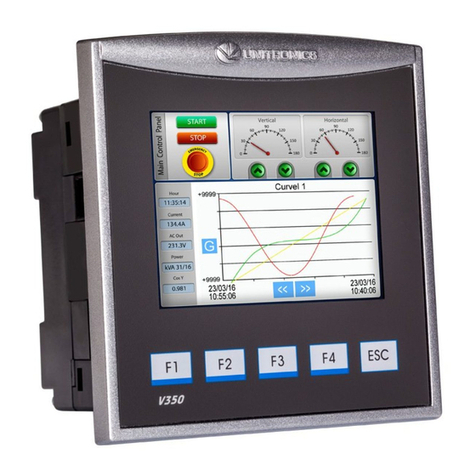
Unitronics
Unitronics Vision OPLC V350-35-TA24 installation guide
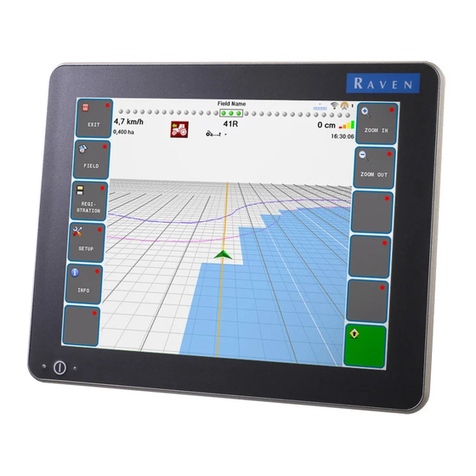
Raven
Raven viper Quick reference guide

Lincoln Electric
Lincoln Electric MAXsa 10 Operator's manual
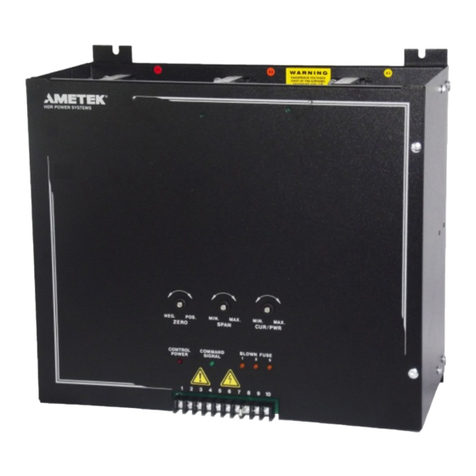
Ametek
Ametek RF3 SCR Series Instruction, Operation and Maintenance Manual
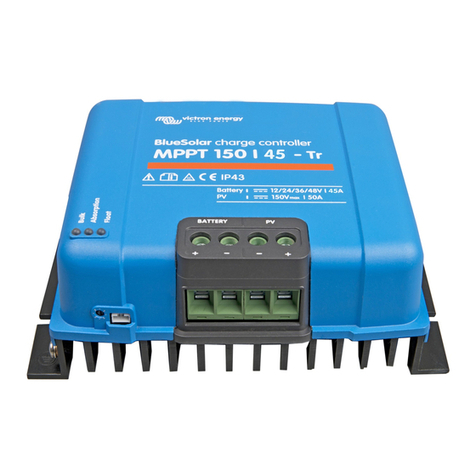
Victron energy
Victron energy BlueSolar MPPT 150/45-Tr user manual
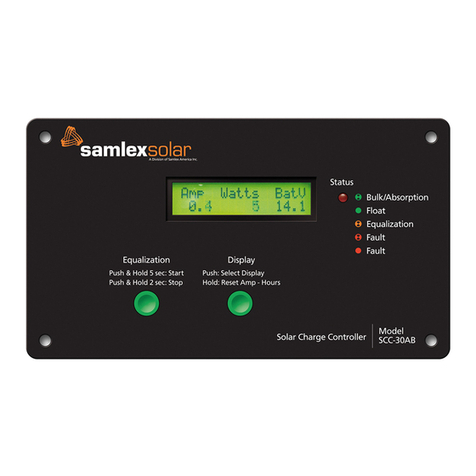
Samlexpower
Samlexpower samlexpower SCC-30AB owner's manual
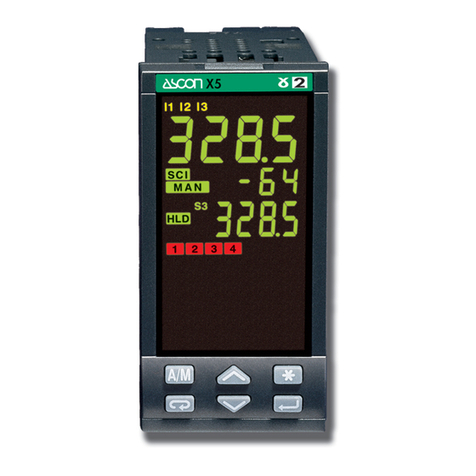
Ascon tecnologic
Ascon tecnologic X5 Series user manual
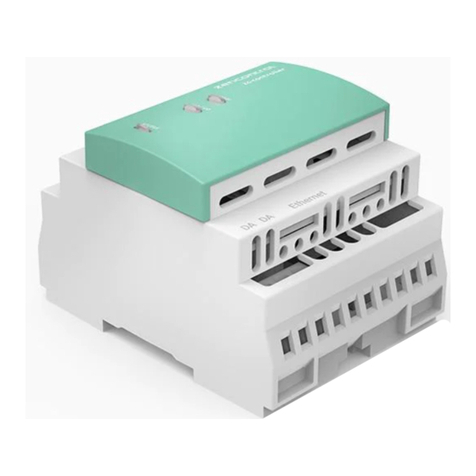
Zencontrol
Zencontrol zc-controller instructions
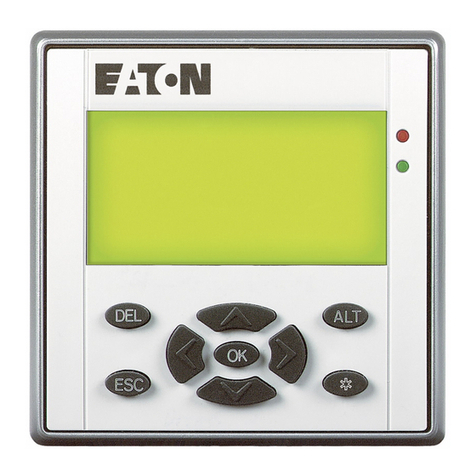
Eaton
Eaton MFD-Titan MFD-80 Series Instruction leaflet

Vasco
Vasco 90.DR020000 installation manual
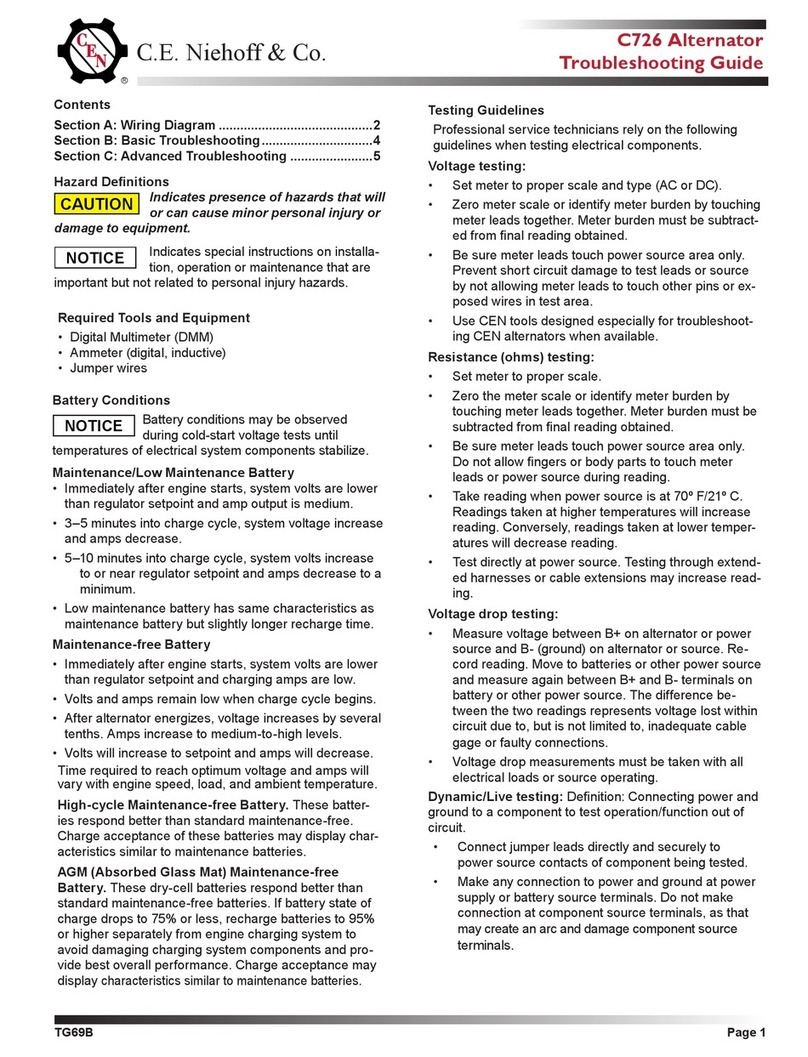
C.E. Nierhoff & Co
C.E. Nierhoff & Co C726 troubleshooting guide
